

Upajjhatthana Sutta. The Upajjhatthana Sutta ("Subjects for Contemplation"), also known as the Abhiṇhapaccavekkhitabbaṭhānasutta in the Chaṭṭha Saṅgāyana Tipiṭaka, is a Buddhist discourse (Pali: sutta; Skt.: sutra) famous for its inclusion of five remembrances, five facts regarding life's fragility and our true inheritance.
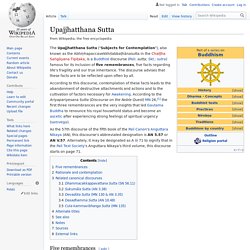
The discourse advises that these facts are to be reflected upon often by all. According to this discourse, contemplation of these facts leads to the abandonment of destructive attachments and actions and to the cultivation of factors necessary for Awakening. According to the Ariyapariyesana Sutta (Discourse on the Noble Quest) MN 26,[1] the first three remembrances are the very insights that led Gautama Buddha to renounce his royal household status and become an ascetic after experiencing strong feelings of spiritual urgency (saṃvega).
Śūnyatā. Śūnyatā, (Sanskrit, also shunyata; Pali: suññatā), in Buddhism, translated into English as emptiness, voidness,[1] openness,[2] spaciousness, vacuity, is a Buddhist concept which has multiple meanings depending on its doctrinal context.
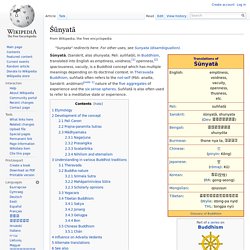
In Theravada Buddhism, suññatā often refers to the not-self (Pāli: anatta, Sanskrit: anātman)[note 1] nature of the five aggregates of experience and the six sense spheres. Suññatā is also often used to refer to a meditative state or experience. Dharmakāya. The Dharmakāya (Sanskrit: धर्म काय; Pali: धम्म कय, lit.
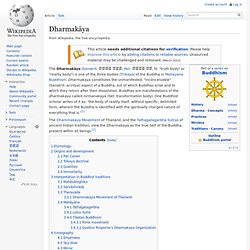
"truth body" or "reality body") is one of the three bodies (Trikaya) of the Buddha in Mahayana Buddhism. Dharmakaya constitutes the unmanifested, "inconceivable" (Sanskrit: acintya) aspect of a Buddha, out of which Buddhas arise and to which they return after their dissolution. Rebirth (Buddhism) Within one life and across multiple lives, the empirical, changing self not only objectively affects its surrounding external world, but also generates (consciously and unconsciously) its own subjective image of this world, which it then lives in as 'reality'.
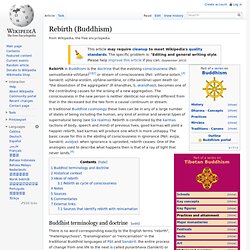
It lives in a world of its own making in various ways. Skandha. In the Theravada tradition, suffering arises when one identifies with or clings to an aggregate.
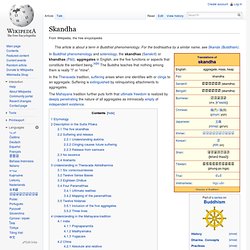
Suffering is extinguished by relinquishing attachments to aggregates. Satipatthana Sutta. "This is the direct way [Pāli: ekāyano ... maggo],[4] monks, for the purification of beings, for the overcoming of sorrow and lamentation, for the extinguishing of suffering and grief, for walking on the path of truth, for the realization of nibbāna....
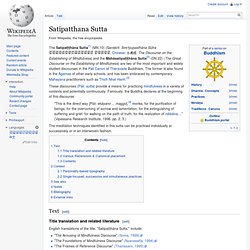
" (Vipassana Research Institute, 1996, pp. 2, 3.) The meditation techniques identified in this sutta can be practiced individually or successively or in an interwoven fashion. Text[edit] Title translation and related literature[edit] Reality in Buddhism. Reality in Buddhism is called dharma (Sanskrit) or dhamma (Pali).
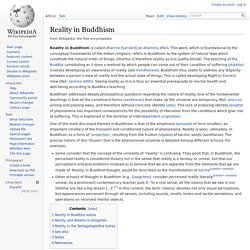
This word, which is foundational to the conceptual frameworks of the Indian religions, refers in Buddhism to the system of natural laws which constitute the natural order of things. Dharma is therefore reality as-it-is (yatha-bhuta). The teaching of the Buddha constituting as it does a method by which people can come out of their condition of suffering (dukkha) involves developing an awareness of reality (see mindfulness). Buddhism thus seeks to address any disparity between a person's view of reality and the actual state of things.
Pratītyasamutpāda. Pratītyasamutpāda (Sanskrit: प्रतीत्यसमुत्पाद; Pali: पटिच्चसमुप्पाद paṭiccasamuppāda) is commonly translated as dependent origination or dependent arising.

The term is used in the Buddhist teachings in two senses: On a general level, it refers to one of the central concepts in the Buddhist tradition—that all things arise in dependence upon multiple causes and conditions.On a specific level, the term is also used to refer to a specific application of this general principle—namely the twelve links of dependent origination. Etymology[edit] Pratityasamutpada (Sanskrit: प्रतीत्यसमुत्पाद) consists of two terms: pratitya: "having depended"samutpada: "arising", "rise, production, origin"[web 1] The term has been translated into English variously as dependent origination, dependent arising,[citation needed] interdependent co-arising,[citation needed] conditioned arising,[citation needed] and conditioned genesis.
Vijñāna. Vijñāna (Sanskrit; Devanagari: विज्ञान) or viññāṇa (Pāli; Devanagari: विञ्ञाण)[1] is translated as "consciousness," "life force," "mind,"[2] or "discernment.
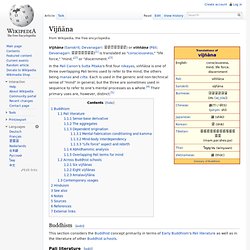
Ātman (Buddhism) Whereas Buddhism generally stresses the non-Self teachings of the Buddha, some Mahāyāna Buddhist sutras and tantras present cataphatic Buddhist teachings with positive language by asserting the ultimate reality of an atman [Self], which is equated with the essential, ultimate nature of mind (Dalai Lama — see relevant section below).
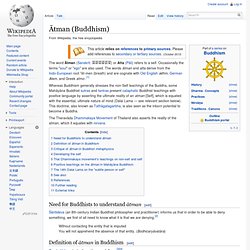
This doctrine, also known as Tathāgatagarbha, is also seen as the inborn potential to become a Buddha. The Theravāda Dhammakaya Movement of Thailand also asserts the reality of the atman, which it equates with nirvana. Śāntideva (an 8th-century Indian Buddhist philosopher and practitioner) informs us that in order to be able to deny something, we first of all need to know what it is that we are denying.[2] Cetanā. Cetanā (Sanskrit, Pali; Tibetan Wylie: sems pa) is a Buddhist term commonly translated as "volition", "intention", "directionality", etc. It can be defined as a mental factor that moves or urges the mind in a particular direction, toward a specific object or goal.[1][2] Cetanā is identified within the Buddhist teachings as follows: Definitions[edit] Theravada[edit] Bhikkhu Bodhi states: Mental factors (Buddhism) Mental factors (Sanskrit: caitasika; Pali: cetasika; Tibetan Wylie: sems byung), in Buddhism, are identified within the teachings of the Abhidharma (Buddhist psychology).
They are defined as aspects of the mind that apprehend the quality of an object, and that have the ability to color the mind. Dzogchen. According to Tibetan Buddhism and Bön, Dzogchen (Rdzogs chen or Atiyoga) is the natural, primordial state or natural condition, and a body of teachings and meditation practices aimed at realizing that condition. Dzogchen, or "Great Perfection", is a central teaching of the Nyingma school also practiced by adherents of other Tibetan Buddhist sects.
According to Dzogchen literature, Dzogchen is the highest and most definitive path to enlightenment.[1] From the perspective of Dzogchen, the ultimate nature of all sentient beings is said to be pure, all-encompassing, primordial clarity or naturally occurring timeless clarity. Mahamudra. Mahāmudrā (Sanskrit, Tibetan: Chagchen, Wylie: phyag chen, contraction of Chagya Chenpo, Wylie: phyag rgya chen po) literally means "great seal" or "great symbol. " It "is a multivalent term of great importance in later Indian Buddhism and Tibetan Buddhism" which "also occurs occasionally in Hindu and East Asian Buddhist esotericism.
Mindstream. Mindstream in Buddhist philosophy is the moment-to-moment continuum (Sanskrit: saṃtāna) of awareness. There are a number of terms in the Buddhist literature that may be rendered as mindstream. For these, see below. The mindstream doctrine, like most Buddhist doctrines, is not homogeneous and shows historical development, different applications according to context and varied definitions employed by different Buddhist traditions. Vijñāna. Saṃjñā. Kleshas (Buddhism) Buddha-nature. Buddha-nature or Buddha Principle refers to several related terms,[note 1] most notably Tathāgatagarbha and Buddhadhātu. Dharmakāya. Yogacara. Yogācāra discourse explains how our human experience is constructed by mind. Nomenclature, orthography and etymology[edit] Vāsanā. Eight Consciousnesses. The Way of Mindfulness: The Satipatthana Sutta and Its Commentary. The Section of the Synopsis. Satipatthana Sutta. 10th sutta in the Majjhima Nikaya. Eugene Gendlin. Stanley Keleman. Stanley Keleman (November 1931 – August 11, 2018)[1] was an American writer and therapist, who created the body psychotherapy approach known as "formative psychology".
Intellectual dark web. Term referring to a group of public personalities who oppose progressive identity politics in the media and academia. Ken Wilber. Memetics. Culture war. Democratic socialism. Postmaterialism. Hyperion. Robert L. Moore. About Merlin — Merlin Sheldrake. 100% Organic & Grass-Fed. John Rawls. Michael Sandel. Communitarianism. Pluralism. A Theory of Justice. Susan Neiman. Utilitarianism. David Bohm. H. G. Wells. Fabian Society. Third Way. Hermeticism. Hermes Trismegistus. Noumenon. Nous. Active imagination. Gary Lachman. Hermeticism. Greenpeace. Oxfam. Anthony Crosland. Nordic model. Social democracy. Anthony Giddens.
Social justice. Equal opportunity. Liberal socialism. Core Knowledge Foundation. E. D. Hirsch. Betrayal trauma. Nassim Haramein. Hans Eysenck. Psychoticism. Trait theory. Big Five personality traits.